I. Introduction: Why Choosing the Right Chicken Feeder Matters
I’ve met plenty of folks who raise chickens on a small scale—mostly just to have fresh eggs and meat for their families. And almost everyone struggles with all sorts of questions: Where should the coop go? How can the chickens have enough space to roam? What kind of feed should they get? And then, there’s the ever-present headache of… rodents.
But there’s one seemingly simple issue that trips up a lot of new chicken keepers: picking the right chicken feeder.
It sounds minor, but the truth is, many beginners wrestle with this problem. Some even give up raising chickens altogether because they can’t figure out a good chicken feeder solution!
So, this article is made just for those who are raising or planning to raise backyard chickens. I’m going to walk you through everything you need to know about choosing a chicken feeder—from how to pick one based on your flock size and coop space, to comparing the pros and cons of the most popular chicken feeder types. And of course, I’ll share tips to prevent feed waste and keep pesky rodents away.
If you want to raise chickens efficiently without getting bogged down by small but annoying problems, keep reading.

II. Comparison of Common Chicken Feeder Types
Types of Chicken Feeders for Chickens 7 Weeks and Older
There are plenty of different types of chicken feeders on the market today, each designed to suit various ages, farming conditions, and user needs. Here’s a rundown of the most popular designs for chickens aged 7 weeks and up:
🔹 1. Open Trough Feeder

This is the simplest type of chicken feeder, usually long and placed directly on the coop floor. It has no lid, with a fully open trough, and is often made from plastic or metal.
• Pros: Easy to find, inexpensive (usually sold in sets, around $10 each), can feed many chickens at once, easy to move and clean.
• Cons: No lid means feed spills easily, rodents can access it, and it doesn’t protect against rain.
🔹 2. Classic Hanging Feeder
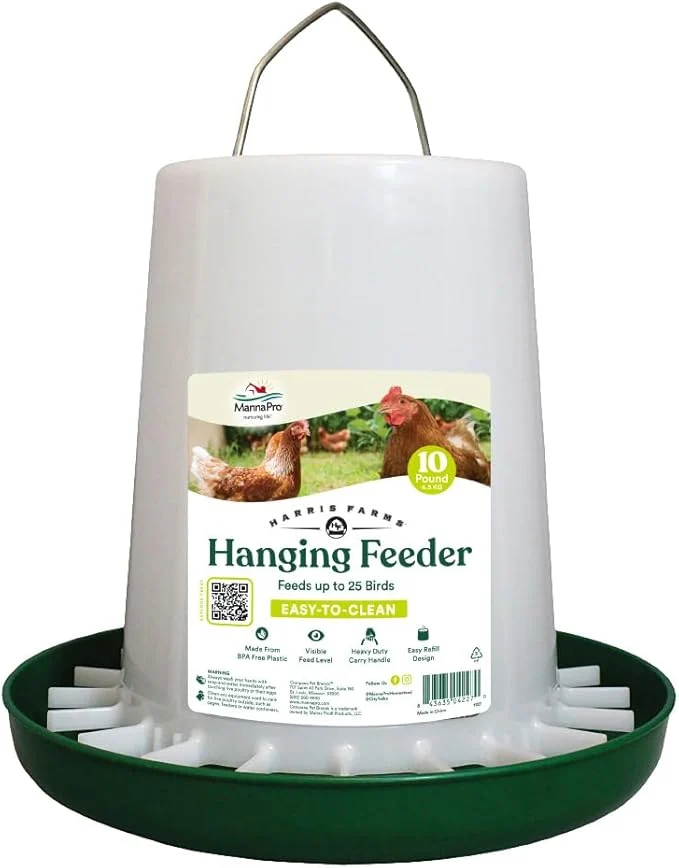
This feeder hangs from a wire or rope in the middle of the coop. It has a tray to reduce feed spillage and is typically made of plastic.
• Pros: Popular, simple, reduces wasted feed, height adjustable to suit chicken size. Affordable, around $15–20.
• Cons: Needs a strong spot to hang it from. Small capacity (about 10 lbs). Doesn’t keep out rain or rodents. Chickens sometimes perch on it and knock over feed.
🔹 3. PVC Tube Feeder

Made from a vertical plastic tube, with feeding holes cut into the side (about 4-inch diameter), mounted along a wall or fence.
• Pros: DIY friendly, space-saving, clean, minimizes feed waste. Costs about $30–40 per feeder.
• Cons: Hard to clean, small capacity (usually under 10 lbs), best for small flocks. Not weatherproof or rodent-proof.
🔹 4. DIY Bucket Feeder
Uses a plastic bucket combined with purchased feeder ports and tools to cut holes.
• Pros: Low cost, easy to make, reduces feed waste, portable, can be rain-resistant (depending on bucket type). Easy to expand for larger flocks. Cost mainly depends on feeder ports, about $3–4 per port.
• Cons: Plastic buckets can get chewed by rodents. If not covered properly, they’re still vulnerable to weather.
🔹 5. Rat-Proof Treadle Chicken Feeder
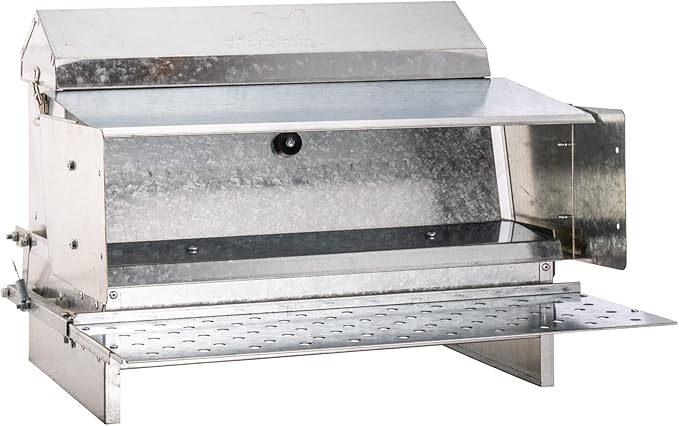
This feeder only opens its door when a chicken steps on the treadle and automatically closes once the chicken steps away. It’s usually made of metal.
• Pros: Effectively keeps rats out, keeps feed dry and clean, available in large capacities suitable for bigger flocks.
• Cons: Expensive (typically $50–200), bulky, hard to move. Chickens need time to get used to it (training is easy by propping the door open or sprinkling feed near the treadle so chickens step on it by chance).
👉 Note: Make sure to choose the right size for your coop.
🔗 Want to see how these feeders work in real coops and which models truly stop rats? Check out our full guide here: Best Rat-Proof Chicken Feeder for Backyard Coops
🔹 6. Wall-Mounted Spring Chicken Feeder
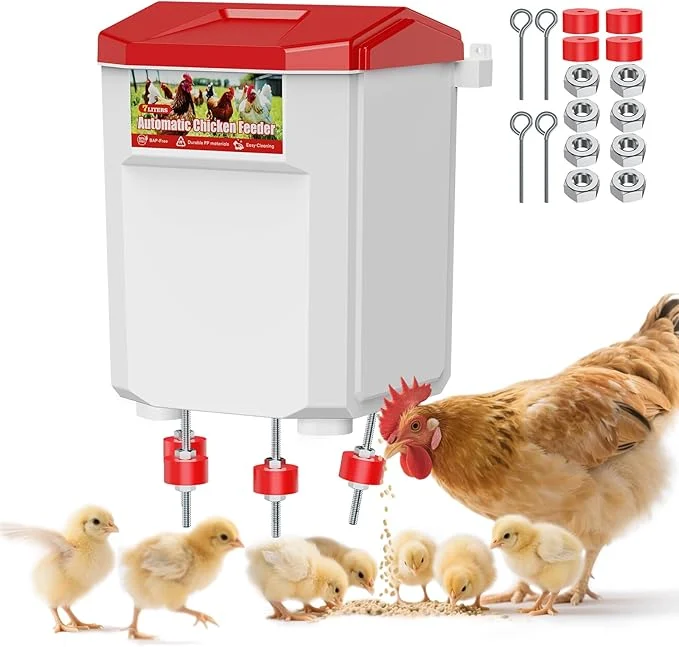
This fixed feeder only dispenses feed when a chicken touches the feeder door. The door closes automatically when not in use. Usually made of plastic.
• Pros: Compact, modern design, reduces feed waste and insects, rodent and rain resistant (usually placed inside the coop).
• Cons: Requires a sturdy wall for mounting. Small capacity (usually under 20 lbs). Price around $50–60.
🔹 7. Smart Automatic Chicken Feeder
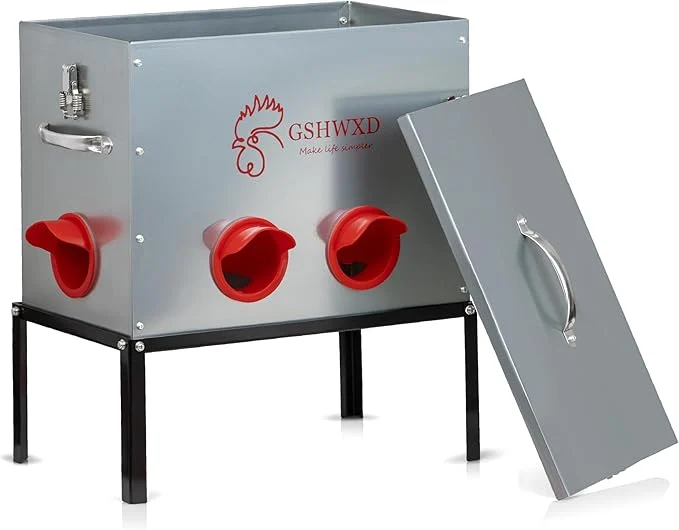
A floor-standing feeder with four legs, usually made of metal.
• Pros: Smart design with feeding openings just big enough for chickens’ necks—rats can’t steal feed. Large capacity (20 lbs or more), usually with 6 feeding ports. Weatherproof, rodent-proof, easy to clean, and has a handle for easy moving.
• Cons: Higher price, typically $100 or more.
Other Specialty Chicken Feeders
Besides the main feeders for adult chickens, there are special designs made for chicks or feeding vegetables:
🔹 1.Baby Chick Feeder

Usually has an inverted dome cover, suitable for both feed and water. Made of plastic with about 4 lbs feed or 30 oz water capacity. Price around $7–8 each.
🔹 2. Hanging Veggie Ball
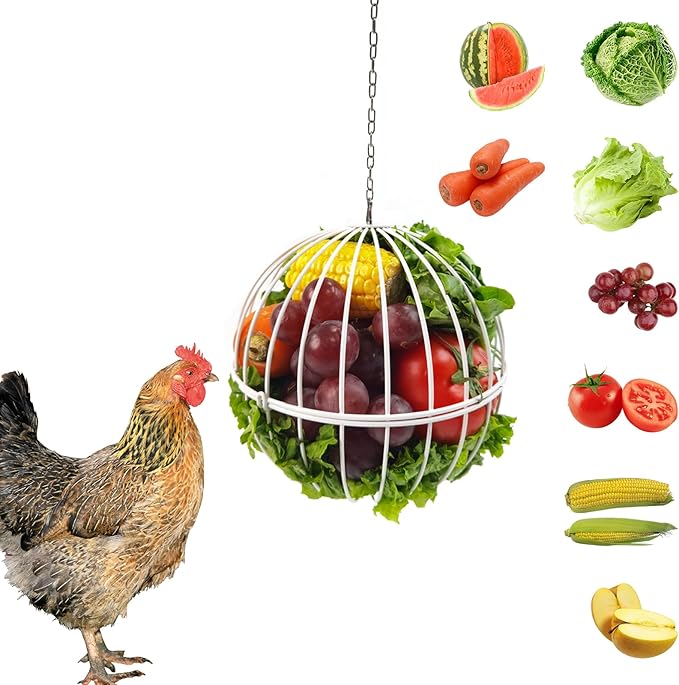
A round mesh design, often made from metal or nylon. Vegetables are placed inside and hung so chickens can peck at them. Some also serve as entertainment toys for chickens. Prices range from $12 to $30 depending on the type.
📏 III. How to Choose a Chicken Feeder for Your Flock
Choosing the Right Chicken Feeder Based on Your Flock Size, Conditions, and Habits
When choosing a chicken feeder, don’t just rely on product photos or general reviews. Every flock and coop setup is different. So start with your actual needs to pick the most suitable and effective feeder. Here are 5 simple questions to help you identify your requirements and make an easy decision:
🐔 1. How many chickens do you have?
Calculating your flock size helps you select a feeder with the right capacity, so you don’t have to refill multiple times a day. Here’s a rough classification of flock sizes and their suitable feeder types (for chickens 7 weeks and older):
• Small flock (3–5 chickens):
You can use open floor feeders, classic hanging feeders, or DIY feeders made from plastic buckets. If you want something tidier and cleaner, the PVC Pipe Chicken Feeder is also a good choice.
• Medium flock (6–10 chickens):
Options include DIY bucket feeders, open trough feeders, PVC Pipe Chicken Feeders, or wall-mounted spring feeders.
• Above medium flock (10–15 chickens):
It’s worth investing in rat-proof treadle feeders, wall-mounted spring feeders, DIY bucket feeders, or smart automatic chicken feeders.
• Large flock (15 or more chickens):
Best to use rat-proof treadle feeders or smart automatic chicken feeders. 👉 Check out our in-depth review of the most popular 50 lb feeders trusted by backyard chicken keepers: Best 40–50 lb Chicken Feeders for Backyard Flocks
🏠 2. Is your coop enclosed or open?
• Enclosed coop (indoors, roofed, low airflow):
You can use open feeders, hanging feeders, or DIY bucket feeders without worrying much about rain or humidity.
• Open or semi-open coop (exposed to rain splashes):
Prioritize modern automatic feeders, rat-proof treadle feeders, or plastic buckets with tight lids to keep feed dry and mold-free.
🐭 3. Do you have problems with rats or feed spillage?
• If rats are common:
Avoid open feeders. Instead, choose treadle feeders, wall-mounted spring feeders, or smart automatic chicken feeders—these are enclosed designs that only let chickens access the feed.
• If feed spills a lot:
Avoid feeders that are too low or lack spill guards. Classic hanging feeders, DIY bucket feeders, treadle feeders, and smart automatic feeders all help reduce spillage.
💰 4. How to Invest Wisely Without Wasting Money?
When it comes to spending on a chicken feeder, expensive doesn’t always mean better, and cheap doesn’t always mean worse. The key is to choose the right product that fits your coop conditions and your flock’s habits. Here are some tips to help you invest smartly—saving money while still being effective:
• Coop with a roof, no rain splash, few or no rats:
➤ No need to spend on expensive rat-proof feeders. You can totally use open feeders, hanging feeders, or DIY PVC pipe feeders.
➤ Just make sure to put out enough feed each time to avoid leftovers causing mold. If there’s minor spillage, the chickens will usually clean it up during the day.
• Experienced chicken keepers with time to care daily:
➤ You don’t necessarily need a large-capacity feeder. A simple DIY plastic bucket feeder or hanging feeder is enough—cheap and easy to clean.
• Large flock or limited time for care:
➤ Consider investing in automatic feeders with treadles or multi-access DIY bucket feeders—these reduce your daily work and prevent crowding while feeding.
• Areas with frequent rats, squirrels, or wild birds:
➤ This is when investing in specialized rat-proof feeders becomes truly necessary. Treadle feeders, enclosed wall-mounted feeders, or advanced automatic feeders will save you a lot of feed in the long run.
• Remember your flock will grow fast—both in weight and number:
➤ A feeder that fits today might not suit your flock after 1–2 months. If you plan to add more chickens or raise them to maturity, pick a feeder that can handle the “future version” of your flock.
✅ In summary: Don’t choose a chicken feeder just by price.
Consider these three factors fully to choose right from the start:
1. Your current and future number of chickens
2. Your coop environment (housing, weather, rodents, insects…)
3. How much time you can dedicate to chicken care daily
👉 Once you consider these carefully, it’s easier to pick the most suitable feeder—durable, efficient, and cost-effective in the long term.
🎁 BONUS: A little gift for readers who reach the end of the article
If you’ve read this far, you’re probably serious about raising chickens at home—and that’s exactly why we want to give you a “small gift” that only those who truly care deserve to know about.
This gift isn’t just theory—it’s from our real experience—people who have raised chickens ourselves, sweat in the coop, met countless backyard chicken keepers, and learned from them.
It is: DIY chicken feeder made from a plastic bucket.
Sounds simple—and yes, it is. But its effectiveness is anything but simple.
This type of feeder has almost everything a chicken keeper needs:
• Much cheaper than most ready-made feeders
• Weatherproof, rat-proof, and reduces feed spillage
• Easy to clean and adjust as your flock grows or increases in number
• Easy to carry and move around
• And most importantly: The least disadvantages among all types of feeders for household flocks that we’ve ever tried
You may not believe it— but try it once and you’ll see why we praise it so highly.
👉 Detailed instructions on how to make, use, and important notes are in this article: How to Make a DIY Plastic Bucket Chicken Feeder – Simple, Effective, Rat-Proof
Of course, nothing is perfect. The downside of this feeder is that plastic isn’t as durable as metal, and if you have very active or large rats, they may still chew through the bucket body.
But you know what? Fixing this is very easy. Just remove the feeding door and attach it to another bucket. It only takes about 5–10 minutes—and you have a brand new feeder with almost no extra cost.
That’s why we call this a “worthy gift” for those who read to the end. Because when you understand the core issue, you’ll see that solutions don’t have to be expensive—just reasonable.
IV. 🛠️ DIY or Buy Ready-Made – Honest Suggestions from Fellow Chicken Keepers Like You
By now, many of you are probably excited and want to grab a bucket right away to make a few feeders, right? 🎉
To help you get started more easily, we’d like to share some sources for materials to DIY bucket feeders, along with ready-made feeders suitable for different needs. Whether you’re new to raising just a few chickens or already have a fast-growing flock of 20, you’ll find suitable options below.
Materials for DIY Bucket Feeder
Open Trough Feeder
Classic Hanging Feeder
PVC Tube Feeder
Rat-Proof Treadle Feeder
Wall-Mounted Spring Feeder
Smart Automatic Feeder
Baby Chick Feeder
Hanging Veggie Ball
❓ V. FAQs – Frequently Asked Questions When Choosing a Chicken Feeder
🐔 1. How many chicken feeders do I need?
The number of feeders depends on the feeder size and your flock size. On average, a 20–25 lb feeder can serve 6–10 adult chickens well. If you have a larger flock, add more feeders or choose bigger ones (e.g., 50 lb feeders or treadle feeders). Don’t forget, distributing feeders evenly around the coop helps reduce competition and ensures every chicken gets enough food.
🐥 2. Can I use the same feeder for chicks and hens?
Not recommended. Chicks need low feeders with narrow openings to easily access food and avoid falling into the feeder or being bullied by older chickens. Also, chick feeders should be easy to clean and minimize spillage. When chicks are about 6–7 weeks old, you can gradually switch them to adult feeders.
🪙 3. Should I buy a plastic or metal feeder?
• Plastic: Lightweight, cheap, rust-free—good for small flocks and covered coops. However, plastic can break easily or get chewed by rats if left outdoors.
• Metal (usually galvanized sheet or stainless steel): More durable, better rat resistance, and weatherproof. But more expensive and heavier to move.
👉 Choose based on your environment and budget—if you keep chickens outdoors and have rat problems, metal feeders are a more durable long-term choice.
⏳ 4. How often should I refill the feeder?
Depends on feeder type and flock size. For example:
• A 10 lb feeder can last 4–5 days for 4–6 adult chickens.
• A 40–50 lb feeder can last 6–7 days for 12–17 chickens.
However, you should check the feeder daily—not only to refill but also to inspect for dampness, clumping, or signs of rat damage.
✅ Conclusion
Choosing the right chicken feeder might sound simple, but in reality, it involves many factors: from the current and future flock size, the coop environment (whether you have rats, the weather conditions), to how much time you want to spend daily caring for your chickens. Each type of feeder—whether a simple hanging feeder, a high-end automatic feeder, or a DIY bucket feeder—has its own strengths suited to specific situations.
If you’ve read this far, you’re probably serious and dedicated to raising chickens at home. And that’s fantastic. Because only by understanding what your flock truly needs can you select a solution that is cost-effective, sustainable, and the best fit.
👉 Remember: There is no “best” feeder for everyone, only the feeder that fits your conditions best. And if you need more advice or aren’t sure where to start, don’t hesitate to revisit the comparison tables, the product suggestions above, or try making a DIY bucket feeder—a special gift from those who’ve been in the trenches raising chickens just like you.

